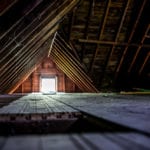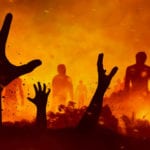 Weird Stuff
Weird Stuff  Weird Stuff
Weird Stuff  Our World
Our World 10 Ways Your Christmas Tree Is More Lit Than You Think
 Movies and TV
Movies and TV The 10 Coolest Stars to Set Sail on The Love Boat
 History
History 10 Things You Didn’t Know About the American National Anthem
 Technology
Technology Top 10 Everyday Tech Buzzwords That Hide a Darker Past
 Humans
Humans 10 Everyday Human Behaviors That Are Actually Survival Instincts
 Animals
Animals 10 Animals That Humiliated and Harmed Historical Leaders
 History
History 10 Most Influential Protests in Modern History
 Creepy
Creepy 10 More Representations of Death from Myth, Legend, and Folktale
 Technology
Technology 10 Scientific Breakthroughs of 2025 That’ll Change Everything
 Weird Stuff
Weird Stuff Ten Bizarre Facts About The Doge Meme
 Our World
Our World 10 Ways Your Christmas Tree Is More Lit Than You Think
 Movies and TV
Movies and TV The 10 Coolest Stars to Set Sail on The Love Boat
Who's Behind Listverse?

Jamie Frater
Head Editor
Jamie founded Listverse due to an insatiable desire to share fascinating, obscure, and bizarre facts. He has been a guest speaker on numerous national radio and television stations and is a five time published author.
More About Us History
History 10 Things You Didn’t Know About the American National Anthem
 Technology
Technology Top 10 Everyday Tech Buzzwords That Hide a Darker Past
 Humans
Humans 10 Everyday Human Behaviors That Are Actually Survival Instincts
 Animals
Animals 10 Animals That Humiliated and Harmed Historical Leaders
 History
History 10 Most Influential Protests in Modern History
 Creepy
Creepy 10 More Representations of Death from Myth, Legend, and Folktale
 Technology
Technology 10 Scientific Breakthroughs of 2025 That’ll Change Everything
Top 10 Creepiest Things Found At Pripyat And Chernobyl
The horrendous 1986 melt-down at the Chernobyl nuclear power plant in the Ukraine, is still the worst nuclear accident in history. In fact, according to the June 17th, 2019, issue of Business Insider magazine, Chernobyl is still considered to be the most severe nuclear disaster in the world, and was worse even than Fukushima in Japan in 2011, and the 1979, Three-Mile Island accident in southeastern Pennsylvania, in the United States. This article commemorates the 35th anniversary of this terrible catastrophe, and is a tribute to the brave men and women, many who gave their lives, to help keep millions safe from its toxic horrors.
Related: 10 Haunting Images Of The Chernobyl Disaster And Their Backstories
10 Ghostly Haunts Of A Catastrophe
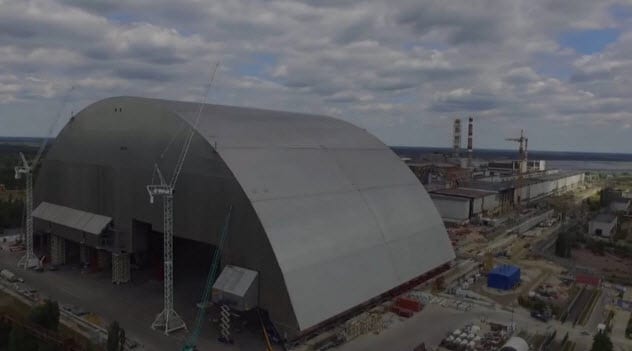
A nuclear physicist from the University of Buffalo named Andrei Kharsukhov, had a horribly frightening experience while at the Chernobyl power plant, when he reported hearing someone screaming for help while there in 1997. He was visiting the infamous “Ground Zero” of the Chernobyl disaster, and said that he got there around 7:30 in the morning and went directly to the Reactor 4 sarcophagus. While taking readings, he reported to officials that he could distinctly hear someone faintly, yet frantically, screaming for help in putting out a fire, so he ran back upstairs and told those who let him in what he saw. But they told him that he was the first one to have entered the place in three years. And not only that, they reminded him that it requires a password to get in, a handprint to enter, and someone going inside without their knowledge would have set off an alarm.
If that isn’t strange enough, before the disaster in early April 1986, people who lived in the area started experiencing really strange occurrences. There were reports by power plant workers of seeing a large, black, bird-like creature, with a twenty-foot wingspan, and large, glowing red eyes that would eventually be dubbed the “Black Bird of Chernobyl.” Those who saw this apparition would also report suffering from things such as horrible nightmares, and getting menacing telephone calls, and that these got worse right up until the very morning of the accident on 26 April, 1986.
Many researchers attribute the things reported at Chernobyl to the “Mothman”—an eerily similar creature, reported to have plagued the town of Point Pleasant, West Virginia, just prior to the 15 December, 1967, failure of the Silver Bridge that killed 46 people. They also contend that historical evidence suggests that this entity appears to be a harbinger of death since Mothman-type creatures have been reported elsewhere in the past and, as in both cases, Chernobyl and the Silver Bridge, the phenomena hasn’t been reported since.
While preforming a paranormal investigation of Chernobyl, and specifically the remnants of Reactor 4, the Destination Truth team from the SyFy channel, were dumbstruck to witness what appeared to be a human figure on an infrared camera system running inside Reactor 4.
9 Nuclear “Shadows” Of Pripyat’s Missing Residents
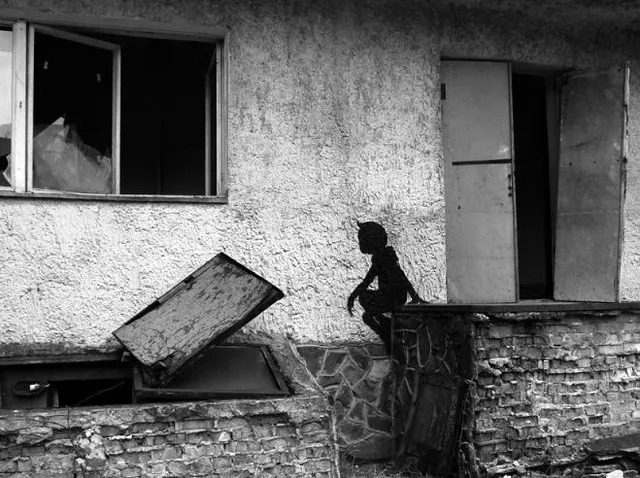
Most of us go out of our way to steer clear of such things as nuclear disaster sites, but some apparently think, “Hey, let’s sneak in and paint the place up!” Rumored to hail from destinations like Belarus and Germany, dark graffiti artists, ignoring reports of deadly radiation levels, over time have slowly stormed the exclusion zone with their arsenal of multi-colored spray paint cans, and left their artistic works—some hauntingly beautiful, while some likewise disturbing—in Pripyat proper, and the surrounding area. Much of the more dramatic graffiti is in the city of Pripyat, where artists portrayed silhouettes of the missing residents of the abandoned city who were evacuated the day after the accident on 27 April, 1986, never to return. For example, in one building, depicted reaching up for a light switch, is a small girl with little bows in her pigtails, while outside, a small boy pulling his toy truck looks to be peeking around a corner as if to surprise someone. In other buildings, walls are adorned with silhouettes of people looking as though dancing, yet in another, three kids are frozen in midair, as if having just jumped from an unseen trampoline, and floating while holding each other—maybe in joy, maybe in horror—that being left up to the viewer. Many feel it is no coincidence that many of these silhouettes are so much like the disturbing “nuclear shadows” left behind by victims of the Hiroshima and Nagasaki atomic bomb attacks that ended WWII.
8 The Abandoned Carnival Of Pripyat
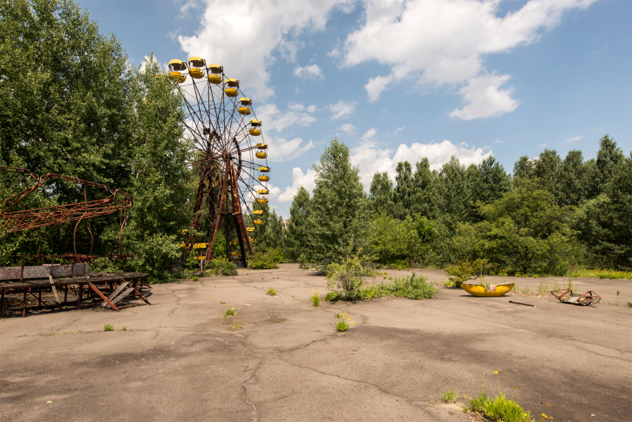
Many might not know that the Pripyat Amusement Park was not yet finished on 26 April, 1986, and so it had never officially opened. Scheduled to do so in just five days on May Day, May 1st, the park stands as a destitute and abandoned icon of the Chernobyl disaster, and a stark reminder of all that could have been. The park featured all-time carnival favorites such as an 85 foot (26 m) Ferris wheel, a parachute ride, bumper cars, boat swings, and a shooting gallery. Many Soviet cities had similar amusement parks dubbed, “Parks of Culture and Rest,” and some are still in operation today, but the Pripyat Amusement Park never did get its “day in the sun,” even though it was briefly opened to the public on 27 April, prior to evacuation orders being given later in the day. Although the park wasn’t ready for patrons, residents were excited to get a chance to visit the fairgrounds, though most of the rides weren’t in service. Today the park sits looming and lonely—a life never lived. The bumper cars sit where they were abruptly left, with leaves swirling around the ride. The Ferris wheel is frozen in place, and the paint is chipping and fading. The paint on the yellow canopies is still bright in spots, but with the orange color of rusty-neglect prevailing elsewhere, silently moaning a forlorn story.
7 The Bloody Red Forest
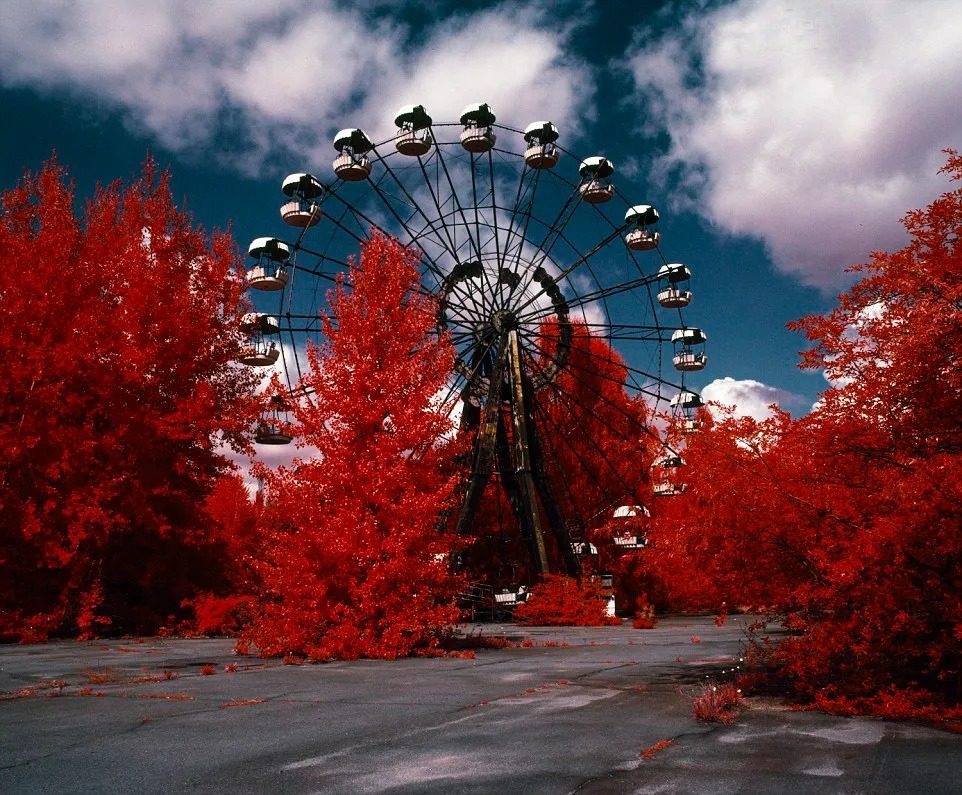
It’s been 35 years since the disaster at the Chernobyl power plant, and although wildlife seems to be thriving, the flora and fauna does offer up some perplexing signs of being radiated. According to a study that began in 1991, the organisms responsible for decomposition and replenishing organic matter back into the ecosystem (such as insects, fungi, and microbes), are presenting symptoms of radioactive contamination. One of the more pronounced phenomena has been dubbed “The Bloody Red Forest,” which is a set of woodland where all the pine trees turned a blood-red color right after the meltdown, and then died not long after. The most disturbing aspect of the Bloody Red Forest is that even after 15 to 20 years after the catastrophe these trees were not decaying, when most rot into dust within a decade of being on the ground. In light of this, scientists decided to run some tests by filling specially-prepared garbage bags with leaf litter from uncontaminated areas, taking care there were no insects or decomposers present, and then leaving the bags out in both contaminated and uncontaminated wooded areas in the exclusion zone for nearly a year to check the decomposition rates of the leaves. Bags left in uncontaminated areas were as expected with normal rates of decomposition between 70% to 90% of the leaves decomposing. But the leaves in contaminated areas retained 60% of their original weight, indicating much less activity by natural decomposers. This suggests that the radiation exposure has had a detrimental effect on the ability of the Chernobyl ecosystem to replenish itself with nutrients, which could be causing the stunting of tree growth that has been recorded. A more pressing problem though, is the fact that the leaves in contaminated areas stayed intact and dry, even after almost a year, and could present a fire hazard, which in turn, presents the danger of radioactive contaminants being spread outside of the exclusion zone by forest fires.
6 The Sad Yet Creepy Dolls Of Pripyat

Horror movies featuring evil dolls that come to life, such as Child’s Play, Dead Silence, and Poltergeist, to name but a few, have always done well at the box office. Maybe it’s their intrinsic creepiness since dolls can appear “dead” even in daylight with their board-like limbs, lifeless eyes, and 1,000 yard stares. But when abandoned to radiate and rot after a nuclear disaster, the affect is greatly magnified, and serves as a stark and truly sorrowful reminder of the tragedy that took place there. The 49,000 residents of Pripyat that were evacuated on 27 April, were told that it was only temporary, so most thought they’d be coming back soon, and left everything they owned behind, including the kids who abandoned their toys—many being left right where they were being played with—since they weren’t allowed to take them with them. So little girls left their precious dolls wherever they were when the evacuation was ordered to start—at home, in school, in nurseries – and many of these dolls were left in the real-life postures that only kids could conceive of in their wonderful young imaginations. Many left in these sad play scenarios have suffered severe radiation damage, making their appearance all that much more disturbing, while the position of some were most likely staged for the cameras of future “dark tourists.” Many of these tragic reminders have been caught on film with their radiated faces, and blank stares in such postures as: peeking out of windows—while wearing gas masks, holding on to each other in an apparent gesture of mutual comfort, resting in the ruins of the catastrophe, laying down peacefully in a bed of roses, or sleeping with their eyes open in their crib. One of the saddest is a tea party of four, forever frozen in time.
5 The Stalkers Of Chernobyl

The Chernobyl “stalkers” are a truly bizarre subculture. They were born out of the suppression and oppression of Soviet history, along with the influx of American-style commercialism that helped breed corruption and then economic crisis in Russia and the Ukraine—or at least that’s what some experts think. In short, stalkers are those who enter the 621-square-mile (1,000 km) exclusion zone illegally, apparently for their own morbid curiosity—kind of like the so-called, “rubber-neckers”—who, when driving by the scene of an accident, just can’t help but strain their necks to gawk as they go by. The phenomenon was “legitimized” in 2007, when Ukrainian computer programmers introduced S.T.A.L.K.E.R.—a post-apocalyptic first-person shooter video game—that takes place in a virtual exclusion zone around Pripyat and Chernobyl. (The acronym stands for “Scavengers, Trespassers, Adventurers, Loners, Killers, Explorers, and Robbers.”) The creators of the game said they wanted to get the word out to the world about Chernobyl, and of course, make a cool video game. S.T.A.L.K.E.R. has done well selling over five million copies, including five sequels, sold mainly in Russia and Eastern Europe.
4 Hospital Of Doom
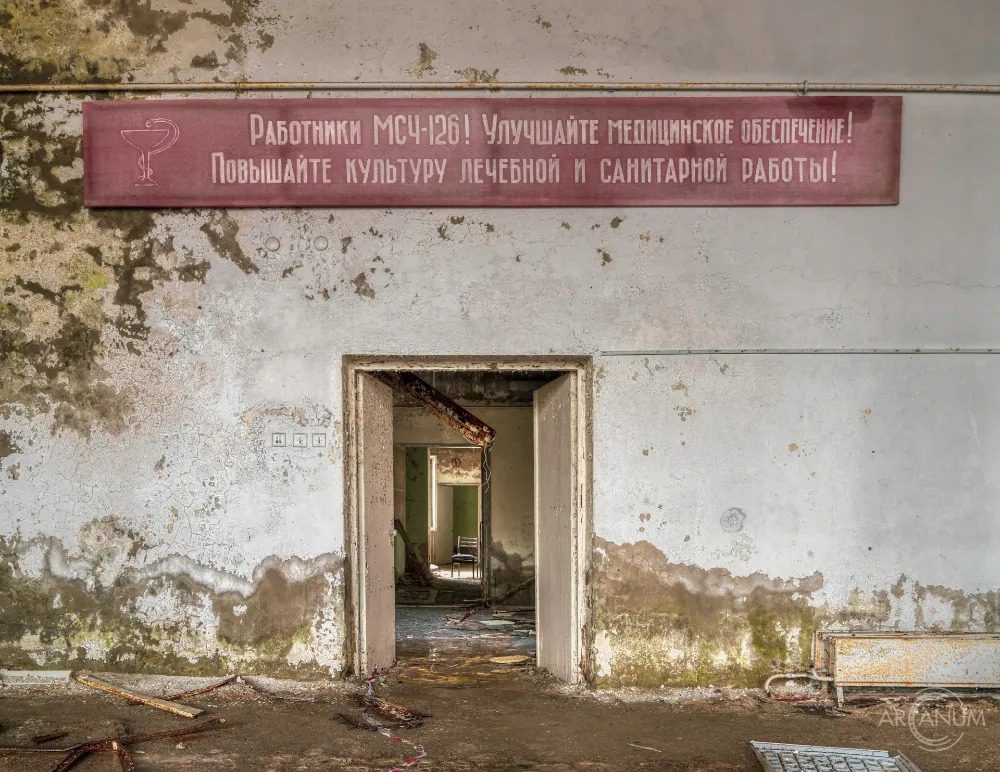
High up on the roof of the Pripyat City Hospital #126, a sign ironically reminded the residents of the freshly-minted Soviet model-city, “Health of the Nation—The Country’s Wealth.” Situated in the micro-district of Pripyat on Druzhby Narodov Street, the hospital’s main wing is part of a sprawling medical complex called, МСЧ-126. Pripyat City Hospital had 410 beds, with clinics and outpatient facilities fanning out that were interconnected. Complete with a dental clinic, maternity ward, infectious disease clinic, and a morgue, the city had been prepared for any emergency they could’ve imagined—the operative word of course being “imagined,” for nobody had foreseen the horrific events of 26 April, 1986. Normally a busy hospital anyway, after Reactor #4 went into meltdown on that fateful night, this is where 237 plant workers, firefighters, and soldiers ended up being treated for severe radiation poisoning, many to never leave alive. According to a 2006 World Health Organization (WHO) report, 28 fireman and rescue personnel died within the first three months. The victims clothes were so radiated they had to be taken to the basement of the hospital where they remain to this day. Eventually, victims were taken to Moscow where the only facility able to treat radiation victims resided. Hospital documents and medical instruments, lay strewn about in haphazard chaos, and the basement is the most radiated location in the city, and had to be abandoned within just days of the incident due to the skyrocketing radiation levels. To this day, many think the place is haunted, since during a paranormal investigation of Chernobyl, the Destination Truth team from the SyFy channel, discovered multiple human-like figures moving through frame in video surveillance taken of the hospital.
3 Radiation-Munching Fungi
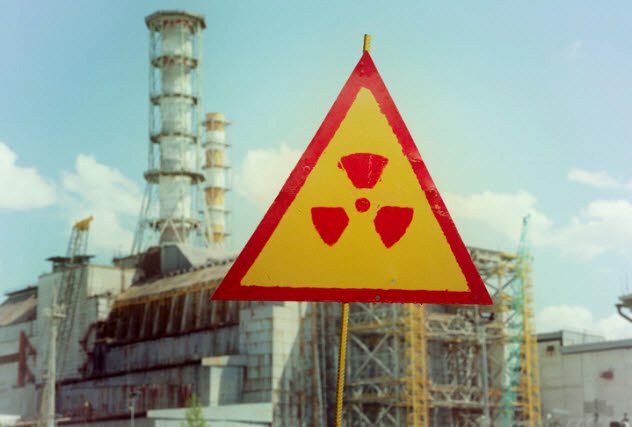
Earth has both a magnetic field and an atmosphere that protects us from dangerous radiation, neutrinos, and cosmic rays from the sun and outer space. NASA knows all to well that astronauts on the International Space Station (ISS) get exposed to twenty times the radiation we get down here on the planet, and that it presents a serious problem to not only the crew, but sensitive electronics also. So after discovering that a fungus called “Cladosporium sphaerospermum” thriving around the heavily-radiated Chernobyl disaster site, consumes radiation through radiosynthesis, they decided to experiment with it in space, and over the course of a month found out that the fungus actually blocks radiation literally by eating it! The experiments on the ISS revealed that Cladosporium was utilizing melanin to transform radioactive gamma rays into chemical energy, and that this ability may turn out to be useful in future space exploration. They are hoping that the fungus may be used to both shield equipment and the crew from deadly radiation during long space flights, and even more importantly, help clean up radioactive waste.
2 Mutated Animals Of Chernobyl
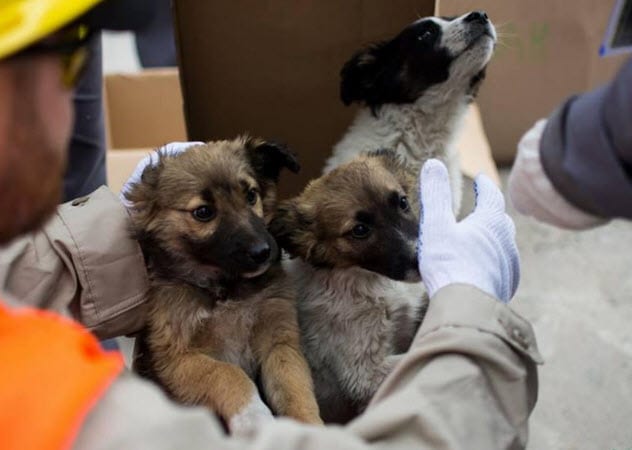
One of the most obvious questions that came up after the 1986 disaster at the Chernobyl nuclear power plant, was whether or not wildlife would suffer from mutations. Hundreds of people died soon after the accident, and along with birth defects, many more have contracted cancer. But scientists around the world were completely surprised to find that the wildlife in the exclusion zone came back much sooner than had been predicted, and life seems to be doing well considering the circumstances. Many researchers thought that life would take decades, maybe centuries to come back from the accident, but it didn’t, and animals are doing rather well for the most part today. But they weren’t surprised at the effects of the radiation, and not all of them were spared. Ten years later it appears that both the wild animals, and the domestic ones left behind, were indeed affected having been born with major birth defects such as multiple heads, muzzles, and legs. They also found other defects such as a cat with two faces; a lamb with eight legs; a two-faced calf; and another calf with legs growing from its back. Plants have also suffered, including the so-called “Red Forest,” a stand of dead, discolored pines that were killed by radiation.
1 The Ukraine’s “Hottest” Tourist Destination
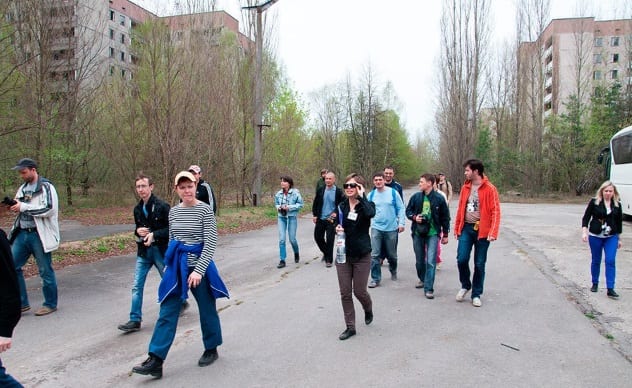
There is a new phenomena dubbed, “dark tourism,” and the Chernobyl disaster site, and the city of Pripyat, are on the top of the list, and quite literally, comprise the “hottest” tourist destination in the Ukraine, no pun intended. In commemoration of the 35th anniversary of the historic tragedy, and made possible by the Covid-19 pandemic, the Ukraine International Airline started offering aerial tours the day before the anniversary of that fateful day when Reactor Number 4 went into meltdown on 26 April, 1986, giving their passengers a unique view of the abandoned nuclear power plant and the city of Pripyat for around $106USD (2,970 Ukraine hryvnia). Their ticket gets them a seat with a panoramic view of the city and the Exclusion Zone from just above the minimum allowed altitude of 3,000 feet (900 m) above Chernobyl on a Embraer 195 jetliner, with a chance to have a selfie taken with the pilot. Although ground-based tours of the Chernobyl control room, and Reactor #4 are available, a hazmat suit is required, making aerial tours an instant hit with tourists with the premiere selling out in two days. Although the coronavirus has severely dampened tourism to the disaster site, it hasn’t stopped it. In 2019, 104,000 tourists visited Chernobyl, whereas in 2020 only 32,000 did, with the highly-popular HBO series “Chernobyl” accounting for 80% of that figure. Chernobyl and Pripyat continue to be visited illegally in spite of the dangers, and the threat of very large fines that can be levied against those who get caught engaging in their “dark obsession.”
